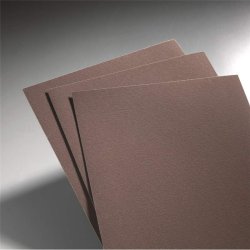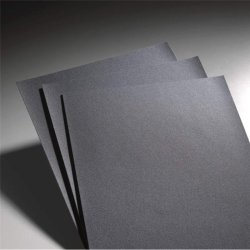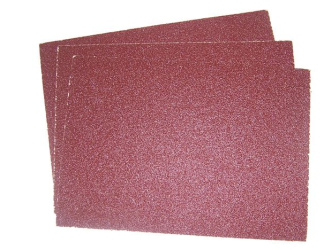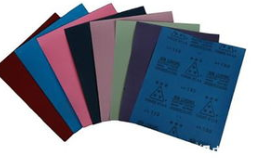Kate135
ww-pappel
Sandpaper
Sandpaper is a paper with abrasive particles attached, used to smooth the surface of an object, or to remove attachments (such as old paint) from the surface of an object. It is also sometimes used to increase friction. Sandpaper is divided into different numbers according to different roughness to suit different uses.
1Basic introduction
Commonly known as sand skin. A material used for grinding.
Used to grind metal, wood and other surfaces to make them smooth and clean.
It is usually made of various abrasive grains glued on the base paper.
According to different abrasive materials, there are many kinds of emery paper, artificial emery paper, glass sandpaper and so on. Dry sanding paper (wood sandpaper) is used to polish the surface of wood and bamboo. Water-resistant sandpaper (water-resistant sandpaper) is used to polish the surface of metal or non-metal workpieces in water or oil.
All base paper is made from unbleached kraft wood pulp.
The paper is strong, wear-resistant and foldable, and has good water resistance.
It is made by adhering abrasive substances such as glass sand to the base paper with an adhesive such as gum and drying it.
2 Classification of sandpaper
Wood sandpaper, that is, dry sanding paper; water sandpaper, that is, water-resistant sandpaper; iron sandpaper, which is a type of dry sanding paper, is thicker and can polish the metal surface as quickly as possible.
In actual use, the classification of sandpaper is very inconsistent.
sponge sandpaper
Suitable for grinding smooth parts on various materials.
The sponge sandpaper sanding process has the characteristics of high production efficiency, good surface quality and low production cost. Therefore, it is widely used in furniture production. The final surface quality of furniture products is closely related to the sanding process. Sponge sandpaper is the main tool in the sanding process.
dry sanding paper
Dry sanding paper uses synthetic resin as a binder to bond silicon carbide abrasive to latex, and coats it with an antistatic coating to make a high-end product. It has the advantages of anti-clogging, anti-static, good softness, and high wear resistance. . Available in a variety of finenesses, suitable for sanding metal surfaces, putties and coatings. Dry sanding paper generally uses special kraft paper and latex paper, uses natural and synthetic resins as binders, and is manufactured through advanced high-static sand planting technology. This product has high grinding efficiency and is not easy to stick to chips, and is suitable for dry sanding. . Widely used in furniture, decoration and other industries, especially for rough grinding.
Water-sanded sandpaper
The texture is relatively fine, and water-sanded sandpaper is suitable for polishing things with fine textures, and is suitable for post-processing;
The gap between the sand grains of water-sanding sandpaper is small, and the grinding particles are also smaller. When used with water, the grinding particles will flow out with the water, so it must be used with water. If you use water-sanding paper for dry grinding, the particles will be broken. It will stay in the gaps between the sand grains, making the surface of the sandpaper dull and unable to achieve its original effect. Dry sandpaper is not that troublesome. The gaps between the sand grains are larger and the grinding debris is larger. During the grinding process, the powder will fall off due to the large gap, so it does not need to be used with water.
Its characteristics are:
1. Adopting linkage line production, the efficiency is high;
2. Since water-resistant sandpaper uses varnish as a binder, it takes a long time to dry, and its drying method generally uses hanging drying;
3. Water-resistant sandpaper generally has a finer grain size. The grain size of water-resistant sandpaper in my country starts from P80, and the fine grain size is connected with the grain size of metallographic sandpaper.
4. Water-resistant sandpaper is generally used for grinding under water-containing conditions, so there is less dust and good working conditions.
Water-resistant sandpaper
Water-resistant sandpaper can be called water-sanding or water-sanding paper. It is named because it can be immersed in water and polished during use. Durable sandpaper is named after durable water paper or polished in water. Durable sandpaper is based on water-resistant paper. It is an abrasive tool made of corundum or silicon carbide abrasives firmly bonded to the substrate using paint or resin as a binder. It has two shapes: page-shaped and roll-shaped. [1]
Dust-free mesh sandpaper
When using dust-free mesh sand to polish, the harm caused by the drift of harmful particles can be minimized. In 2013, whether it is a sanding disc or a sanding strip, Mirka dust-free mesh sand has a rich range of particle sizes for you to choose from to meet the needs of different sanding operations. Whether it is automobiles, yachts, engineering construction or even aircraft manufacturing, dust-free mesh sand is your best choice. In addition, the particle size range from P80 to P1000 can ensure that all your dust-free sanding operations can be completed in one go.
Compared with traditional grinding materials, there is no clogging. This feature greatly extends the service life of Abranet products; there are very few clumping, and efficient vacuuming fundamentally solves the problem of clumping; extremely high efficiency, greatly reducing The frequency of replacement of sand discs improves work efficiency.
Sandpaper is a paper with abrasive particles attached, used to smooth the surface of an object, or to remove attachments (such as old paint) from the surface of an object. It is also sometimes used to increase friction. Sandpaper is divided into different numbers according to different roughness to suit different uses.
1Basic introduction
Commonly known as sand skin. A material used for grinding.
Used to grind metal, wood and other surfaces to make them smooth and clean.
It is usually made of various abrasive grains glued on the base paper.
According to different abrasive materials, there are many kinds of emery paper, artificial emery paper, glass sandpaper and so on. Dry sanding paper (wood sandpaper) is used to polish the surface of wood and bamboo. Water-resistant sandpaper (water-resistant sandpaper) is used to polish the surface of metal or non-metal workpieces in water or oil.
All base paper is made from unbleached kraft wood pulp.
The paper is strong, wear-resistant and foldable, and has good water resistance.
It is made by adhering abrasive substances such as glass sand to the base paper with an adhesive such as gum and drying it.
2 Classification of sandpaper
Wood sandpaper, that is, dry sanding paper; water sandpaper, that is, water-resistant sandpaper; iron sandpaper, which is a type of dry sanding paper, is thicker and can polish the metal surface as quickly as possible.
In actual use, the classification of sandpaper is very inconsistent.
sponge sandpaper
Suitable for grinding smooth parts on various materials.
The sponge sandpaper sanding process has the characteristics of high production efficiency, good surface quality and low production cost. Therefore, it is widely used in furniture production. The final surface quality of furniture products is closely related to the sanding process. Sponge sandpaper is the main tool in the sanding process.
dry sanding paper
Dry sanding paper uses synthetic resin as a binder to bond silicon carbide abrasive to latex, and coats it with an antistatic coating to make a high-end product. It has the advantages of anti-clogging, anti-static, good softness, and high wear resistance. . Available in a variety of finenesses, suitable for sanding metal surfaces, putties and coatings. Dry sanding paper generally uses special kraft paper and latex paper, uses natural and synthetic resins as binders, and is manufactured through advanced high-static sand planting technology. This product has high grinding efficiency and is not easy to stick to chips, and is suitable for dry sanding. . Widely used in furniture, decoration and other industries, especially for rough grinding.
Water-sanded sandpaper
The texture is relatively fine, and water-sanded sandpaper is suitable for polishing things with fine textures, and is suitable for post-processing;
The gap between the sand grains of water-sanding sandpaper is small, and the grinding particles are also smaller. When used with water, the grinding particles will flow out with the water, so it must be used with water. If you use water-sanding paper for dry grinding, the particles will be broken. It will stay in the gaps between the sand grains, making the surface of the sandpaper dull and unable to achieve its original effect. Dry sandpaper is not that troublesome. The gaps between the sand grains are larger and the grinding debris is larger. During the grinding process, the powder will fall off due to the large gap, so it does not need to be used with water.
Its characteristics are:
1. Adopting linkage line production, the efficiency is high;
2. Since water-resistant sandpaper uses varnish as a binder, it takes a long time to dry, and its drying method generally uses hanging drying;
3. Water-resistant sandpaper generally has a finer grain size. The grain size of water-resistant sandpaper in my country starts from P80, and the fine grain size is connected with the grain size of metallographic sandpaper.
4. Water-resistant sandpaper is generally used for grinding under water-containing conditions, so there is less dust and good working conditions.
Water-resistant sandpaper
Water-resistant sandpaper can be called water-sanding or water-sanding paper. It is named because it can be immersed in water and polished during use. Durable sandpaper is named after durable water paper or polished in water. Durable sandpaper is based on water-resistant paper. It is an abrasive tool made of corundum or silicon carbide abrasives firmly bonded to the substrate using paint or resin as a binder. It has two shapes: page-shaped and roll-shaped. [1]
Dust-free mesh sandpaper
When using dust-free mesh sand to polish, the harm caused by the drift of harmful particles can be minimized. In 2013, whether it is a sanding disc or a sanding strip, Mirka dust-free mesh sand has a rich range of particle sizes for you to choose from to meet the needs of different sanding operations. Whether it is automobiles, yachts, engineering construction or even aircraft manufacturing, dust-free mesh sand is your best choice. In addition, the particle size range from P80 to P1000 can ensure that all your dust-free sanding operations can be completed in one go.
Compared with traditional grinding materials, there is no clogging. This feature greatly extends the service life of Abranet products; there are very few clumping, and efficient vacuuming fundamentally solves the problem of clumping; extremely high efficiency, greatly reducing The frequency of replacement of sand discs improves work efficiency.





